The global lactose-free butter market is valued at USD 333 million in 2025 and is expected to reach USD 655.1 million by 2035, reflecting a CAGR of 7%. Growth is expected to be driven by the rising prevalence of lactose intolerance, increasing consumer preference for clean-label dairy alternatives, and expanding availability of lactose-free butter across both online and offline retail platforms. A surge in veganism and heightened awareness of digestive health are also contributing to the market's acceleration.
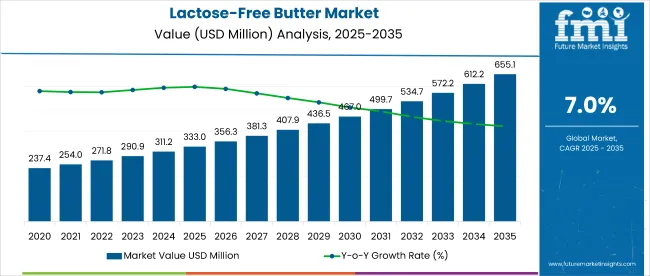
| Metric | Value |
|---|---|
| Estimated Size (2025E) | USD 333 million |
| Projected Value (2035F) | USD 655.1 million |
| CAGR (2025 to 2035) | 7% |
The UK is expected to lead the global market in Europe with the highest market share, expected to expand at a CAGR of 7.9%. Meanwhile, Germany and the USA closely follow this growth with respective CAGRs of 6.5% and 6.2%. Spreadable lactose-free butter will dominate the market due to its favorable texture and ease of use, accounting for 55% of the market share, while cream-based lactose-free butter by source accounts for 49% of the market share in 2025.
The market holds a small but steadily growing share across its parent markets. Within the butter market, it accounts for 3% to 5%, driven by rising demand among lactose-intolerant consumers. In the broader lactose-free dairy market, it represents about 7% to 9%, with growth fueled by clean-label and digestive wellness trends.
Its share in the dairy products market is still marginal at below 1%, while in the plant-based dairy alternatives market, it contributes around 2% to 3%, primarily through vegan butter variants. The segment continues to expand due to health and dietary awareness globally.
Looking ahead, government initiatives promoting digestive health awareness and plant-based nutrition will create further opportunities in this space. Several companies are investing in R&D to develop flavored and fortified lactose-free butter, including versions infused with avocado oil and omega fatty acids.
As online grocery adoption accelerates, the e-commerce distribution channel will gain further prominence. Innovation, sustainability, and transparency in labeling will continue to define market differentiation strategies over the coming decade. Additionally, product innovation in terms of flavor and formulation is further supporting demand in both developed and emerging markets.
The market is segmented into product type, nature, source, end use, distribution channel and region. By product type, the market is bifurcated into spreadable and non-spreadable. By nature, the market is segmented into organic and conventional.
By source, the market includes cream, milk, skimmed and whole. By end use, the market is segmented into HoReCa/foodservice, household/retail, food industry, bakery & confectionery, meat products, infant formula and desserts.
By distribution channel, the market is bifurcated into direct and retail (hypermarkets/supermarkets, convenience stores, specialty stores, independent retailers & online). Regionally, the market covers North America, Latin America, Europe, Asia Pacific, the Middle East & Africa.
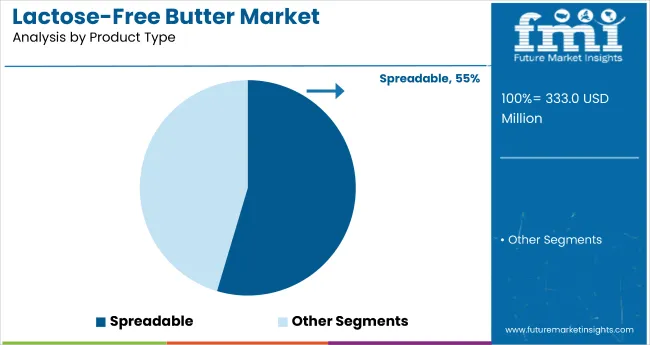
Spreadable is projected to dominate the product type segment, holding a 55% market share in 2025. This leading position is attributed to its convenience, smooth texture, and ease of use straight from refrigeration. Spreadable lactose-free butter is widely favored across both household and foodservice sectors, especially in urban regions where consumer preference leans toward ready-to-use and health-conscious dairy alternatives.

Conventional lactose-free butter is projected to dominate the nature segment with over 78% of the market share in 2025. Traditional options are more cost-effective and widely distributed, making them appealing to budget-conscious consumers. While organic lactose-free butter is experiencing growth, its premium pricing and limited shelf space in emerging markets continue to restrict faster adoption.
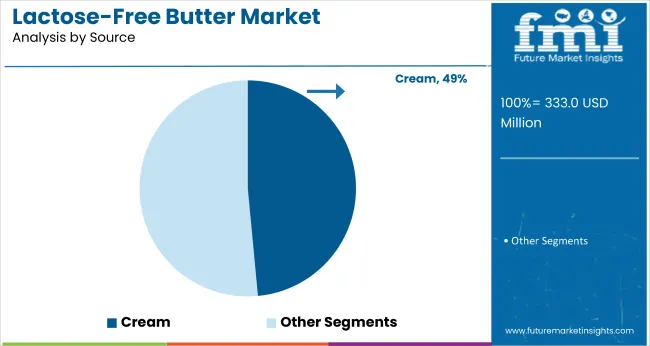
Cream-based lactose-free butter is projected to account for the largest share under the source segment, estimated at 49% in 2025. Cream offers a rich texture, superior mouthfeel, and is commonly used by established manufacturers. Milk, skimmed, and whole variants are also being developed to address specific nutritional and flavor requirements. Skimmed and whole milk sources cater to niche needs focused on fat- or calorie-specific dietary preferences.
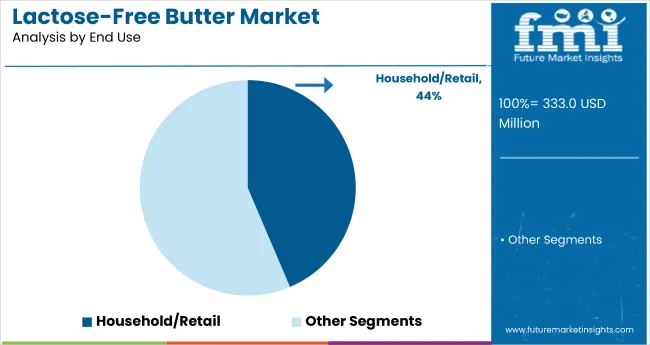
The household or retail segment is expected to hold the highest share of 44% in 2025. Lactose-free butter is gaining popularity in domestic consumption as awareness of lactose intolerance and dietary health continues to grow. The HoReCa and bakery/confectionery sectors are also witnessing increased uptake, with foodservice operators adopting lactose-free options to cater to vegan and health-sensitive consumers.
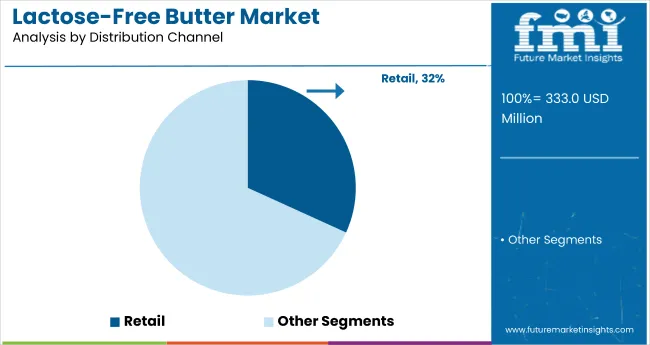
Retail is expected to dominate the distribution channel with a 32% market share in 2025. These channels offer high visibility, consumer trust, and ample shelf space for branded lactose-free butter. However, the online segment is projected to witness the fastest growth as digital grocery sales accelerate following the pandemic. Direct distribution remains limited to institutional bulk purchases and B2B contracts.
Recent Trends in the Lactose-Free Butter Market
Challenges in the Lactose-Free Butter Market
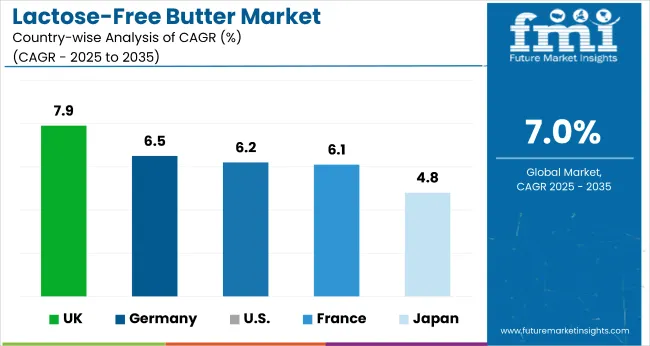
Among the top five countries in the market, the UK is projected to grow the fastest, registering a CAGR of 7.9% from 2025 to 2035. This growth is fueled by rising clean-label preferences, increased multicultural influence, and a growing vegan population. Germany follows with a 6.5% CAGR, driven by high lactose intolerance and strong intra-European exports. The USA is close behind with a 6.2% CAGR, supported by a mature market, expanding Hispanic population, and rapid growth in online ethnic retail.
France is expected to grow steadily at 6.1%, led by demand for artisanal products. Japan, while slower, is still set to grow at a 4.8% CAGR due to increasing digestive health awareness and improved access through online retail. Together, these markets reflect a growing global appetite for culturally inspired offerings.
The report covers an in-depth analysis of 40+ countries; five top-performing OECD countries are highlighted below.
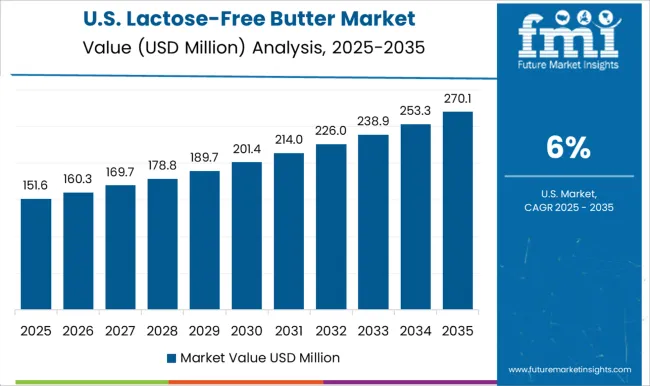
The lactose-free butter revenue in the USA is projected to expand at a CAGR of 6.2% from 2025 to 2035. A mature dairy market, growing awareness of lactose intolerance, and the popularity of functional dairy alternatives have boosted demand across both the retail and HoReCa sectors. Major retailers and D2C platforms are expanding their lactose-free dairy offerings, while national brands focus on organic, flavored, and health-oriented formulations to maintain a competitive edge.
The lactose-free butter market in the UK is anticipated to grow at a CAGR of 7.9% between 2025 and 2035. As consumers become more health-conscious and increasingly prefer clean-label food items, lactose-free butter is gaining popularity among vegans and individuals with dairy sensitivities. Retail chains and independent health food stores serve as major distribution hubs for lactose-free products, including premium and flavored butter variants.
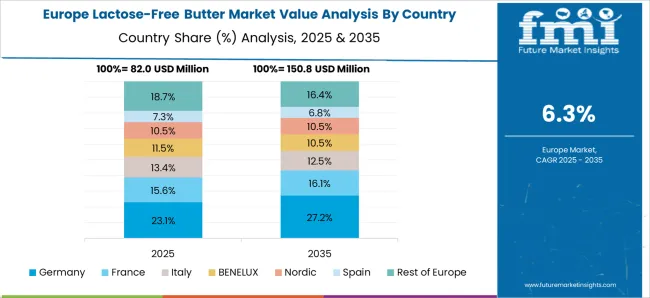
Sales of lactose-free butter in Germany are projected to flourish at a CAGR of 6.5% from 2025 to 2035, making it the leading market in Europe for lactose-free butter. A high prevalence of lactose intolerance, combined with strong consumer preference for high-quality, low-lactose dairy products, is driving robust demand. Manufacturers in Germany are investing in product innovations, including omega-rich and herb-infused butter.
Revenue of lactose-free butter in France is estimated to rise at a CAGR of 6.1% from 2025 to 2035. The market is driven by rising lactose sensitivity, a growing preference for clean-label dairy, and the increasing prominence of artisanal and specialty butter brands. Premium retail and gourmet food outlets are increasingly showcasing lactose-free variants, especially those made with organic cream and authentic regional ingredients.
The lactose-free butter market in Japan is projected to grow at a CAGR of 4.8% from 2025 to 2035. Rising consumer awareness about lactose intolerance and digestive wellness is gradually driving demand. The market is supported by a strong retail infrastructure, growing online food commerce, and increasing demand for low-cholesterol, functional food products aligned with health trends.

The global market is moderately fragmented, with a mix of regional dairy cooperatives, global food conglomerates, and emerging plant-based innovators. Key players such as Agropur Dairy Cooperative, Challenge Dairy, Valio Ltd., and Miyoko’s Creamery are actively competing on innovation, flavor development, and clean-label claims, while large multinationals like The Kraft Heinz Company and Kerry Group focus on portfolio expansion and global retail partnerships.
Company strategies are focused on developing lactose-free butter with added functional benefits, including omega-3 fatty acids and fortified nutrients, alongside allergen-free and vegan options. Pricing competitiveness, localized production to meet regulatory compliance, and e-commerce retail partnerships are being prioritized.
For instance, companies like Miyoko’s Creamery and Valio Ltd. are leveraging plant-based technologies and sustainable packaging to align with eco-conscious consumer demand. Meanwhile, dairy giants such as Agropur and Parmalat S.p.A is maintaining leadership through robust distribution networks and targeted acquisitions to penetrate the clean dairy segment.
Recent Lactose-Free Butter Industry News
| Report Attributes | Details |
|---|---|
| Current Total Market Size (2025) | USD 333 million |
| Projected Market Size (2035) | USD 655.1 million |
| CAGR (2025 to 2035) | 7% |
| Base Year for Estimation | 2024 |
| Historical Period | 2020 to 2024 |
| Projections Period | 2025 to 2035 |
| Market Analysis Parameters | Revenue in USD millions / Volume in Kilotons |
| By Product Type | Spreadable and Non-Spreadable |
| By Nature | Organic and Conventional |
| By Source | Cream, Milk, Skimmed, and Whole |
| By End Use | HoReCa/Foodservice, Household/Retail, Food Industry, Bakery and Confectionery, Meat Products, Infant Formula, and Desserts |
| By Distribution Channel | Direct, and Retail (Hypermarkets/Supermarkets, Convenience Stores, Specialty Stores, Independent Retailers, Online) |
| Regions Covered | North America, Latin America, Europe, East Asia, South Asia, Oceania, Middle East & Africa |
| Countries Covered | United States, Canada, United Kingdom, Germany, France, China, Japan, South Korea, Brazil, Australia and 40+ countries |
| Key Players | Agropur Dairy Cooperative, Challenge Dairy, Parmalat S.p.A, Uelzena Ingredients, CAPSA Food, Valio Ltd., Butterfields Butter LLC, Miyoko’s Creamery, Molkerei Biedermann AG, The Kraft Heinz Company, The Hain Celestial Group, Inc., Cargill Inc., Corbion Inc., Kerry Group PLC, Ingredion Incorporated, General Mills, Inc., DuPont, Kellogg Company, Chr. Hansen A/S |
| Additional Attributes | Dollar sales by value, market share analysis by segments, and country-wise insights |
The global lactose-free butter market is estimated to be valued at USD 333.0 million in 2025.
The market size for the lactose-free butter market is projected to reach USD 655.1 million by 2035.
The lactose-free butter market is expected to grow at a 7.0% CAGR between 2025 and 2035.
The key product types in lactose-free butter market are spreadable butter and non-spreadable butter.
In terms of nature, organic butter segment to command 41.8% share in the lactose-free butter market in 2025.






Our Research Products

The "Full Research Suite" delivers actionable market intel, deep dives on markets or technologies, so clients act faster, cut risk, and unlock growth.

The Leaderboard benchmarks and ranks top vendors, classifying them as Established Leaders, Leading Challengers, or Disruptors & Challengers.

Locates where complements amplify value and substitutes erode it, forecasting net impact by horizon

We deliver granular, decision-grade intel: market sizing, 5-year forecasts, pricing, adoption, usage, revenue, and operational KPIs—plus competitor tracking, regulation, and value chains—across 60 countries broadly.

Spot the shifts before they hit your P&L. We track inflection points, adoption curves, pricing moves, and ecosystem plays to show where demand is heading, why it is changing, and what to do next across high-growth markets and disruptive tech

Real-time reads of user behavior. We track shifting priorities, perceptions of today’s and next-gen services, and provider experience, then pace how fast tech moves from trial to adoption, blending buyer, consumer, and channel inputs with social signals (#WhySwitch, #UX).

Partner with our analyst team to build a custom report designed around your business priorities. From analysing market trends to assessing competitors or crafting bespoke datasets, we tailor insights to your needs.
Supplier Intelligence
Discovery & Profiling
Capacity & Footprint
Performance & Risk
Compliance & Governance
Commercial Readiness
Who Supplies Whom
Scorecards & Shortlists
Playbooks & Docs
Category Intelligence
Definition & Scope
Demand & Use Cases
Cost Drivers
Market Structure
Supply Chain Map
Trade & Policy
Operating Norms
Deliverables
Buyer Intelligence
Account Basics
Spend & Scope
Procurement Model
Vendor Requirements
Terms & Policies
Entry Strategy
Pain Points & Triggers
Outputs
Pricing Analysis
Benchmarks
Trends
Should-Cost
Indexation
Landed Cost
Commercial Terms
Deliverables
Brand Analysis
Positioning & Value Prop
Share & Presence
Customer Evidence
Go-to-Market
Digital & Reputation
Compliance & Trust
KPIs & Gaps
Outputs
Full Research Suite comprises of:
Market outlook & trends analysis
Interviews & case studies
Strategic recommendations
Vendor profiles & capabilities analysis
5-year forecasts
8 regions and 60+ country-level data splits
Market segment data splits
12 months of continuous data updates
DELIVERED AS:
PDF EXCEL ONLINE
Butter Coffee Market Size and Share Forecast Outlook 2025 to 2035
Butter Market Insights - Dairy Industry Expansion & Consumer Trends 2025 to 2035
Buttermilk Powder Market Analysis by Product Type, Sale Channel, and Region Through 2035
Butterfly Valves Market Analysis by Type, Mechanism, Function, Applications, and Region through 2035
Butter Flavor Market Trends – Food & Beverage Innovation 2025 to 2035
Butter Powder Market Growth – Applications & Demand 2025 to 2035
Analysis and Growth Projections for Butter and Margarine Business
Competitive Breakdown of Buttermilk Powder Providers
Butter Concentrate Market
Nut Butters Market Insights - Premium Spreads & Consumer Trends 2025 to 2035
Dry Buttermilk Market
Shea Butter Market Analysis - Size, Share, & Forecast Outlook 2025 to 2035
Aloe Butter Market
Kokum Butter Market Analysis by Application, End Use, and Region through 2035
Vegan Butter Market Insights - Dairy-Free Alternatives & Industry Growth 2025 to 2035
Cocoa Butter Market Analysis by Product Type, Nature, Form, and End Use Through 2035
Peanut Butter Market Analysis - Size, Share, and Forecast Outlook 2025 to 2035
Peanut Butter Keto Snacks Market Analysis - Trends & Growth 2025 to 2035
Lactic Butter Market Analysis - Size, Share & Forecast 2025 to 2035
Almond Butter Market Growth - Healthy Spreads & Industry Demand 2025 to 2035

Thank you!
You will receive an email from our Business Development Manager. Please be sure to check your SPAM/JUNK folder too.
Chat With
MaRIA